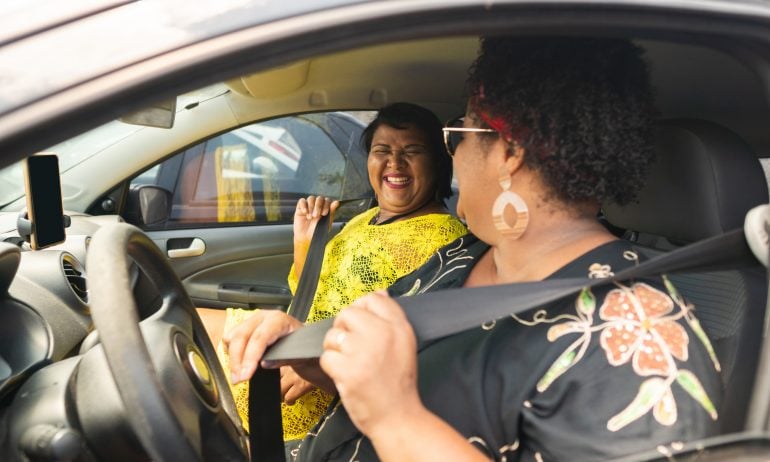What Does ‘Out-the-Door’ Price Mean?
The out-the-door price is the total amount you'll pay for your car, truck or SUV.

Many, or all, of the products featured on this page are from our advertising partners who compensate us when you take certain actions on our website or click to take an action on their website. However, this does not influence our evaluations. Our opinions are our own. Here is a list of our partners and here's how we make money.
The out-the-door price of a car is the amount you would pay to walk out of the dealer’s door with keys in hand.
Sometimes abbreviated as OTD, the out-the-door price includes all taxes, fees and extras. Knowing this number when buying a car can help you stay within your budget and maintain a strong negotiating position.
If you're writing a check, the out-the-door price is the amount you would fill in. If you're taking out a loan, the amount you borrow and the out-the-door price would match.
What the out-the-door price includes
The out-the-door price is a single number that typically includes:
Sales price of the vehicle.
Destination charge, if the vehicle is new.
Sales taxes.
Registration fees.
Title fees.
Documentation fees.
Dealer-added extras, which are often listed on a window sticker.
Warranties, gap insurance and other financial products you agree to purchase.
Market adjustment, also known as added dealer markup.
If you’re trading in a vehicle or making a down payment, those amounts are deducted to determine an out-the-door price.
Don’t mistake the out-the-door price for the total cost of owning a car. To reach that number, you would have to factor in additional things, like the cost of insurance and the interest you might pay during the term of a loan.
Ultimately, the out-the-door price paints a clear picture of what you're buying when you’re at the dealership. Instead of focusing solely on your monthly payment or not paying a specific fee, determining the out-the-door price can save you from overlooking the true price of the car.
Explore the auto-buying platforms from our partners below.
AD
Use out-the-door price when negotiating
In recent years, the shortage-driven car market left many auto dealers unwilling to negotiate the price of a car. With inventories returning to normal, the door to negotiating is beginning to open again.
In fact, add-ons and fees can inflate a car’s asking price by thousands of dollars. It’s not always clear what the dealer will negotiate on, which fees are mandated by law and how you can find the best deal.
That’s why your most powerful bargaining strategy is not to negotiate individual extras, but to ask the question that reduces the number of moving parts to one: “What’s my out-the-door price?”
Negotiating the out-the-door price:
Reduces confusion by allowing you to focus on a single number.
Reveals all costs, hidden fees and add-ons.
Allows you to make apples-to-apples comparisons of offers from different dealers.
Protects you from negotiating on the monthly payment, a favorite tactic at dealerships.
Avoids last-minute surprises when you review the sales contract.
Helps you set a budgeted price and adhere to it.
Another reason to use OTD in your negotiation is that it can keep temptation in check. Without a full picture of the long-term costs, you might be tempted to finance a more expensive car.
For instance, a $600 monthly payment at 9.29% annual percentage rate means you can finance $23,977 for 48 months — but $33,021 if you stretch to 72 months. That sounds great until you compare how much interest you would pay: $4,822 vs. $10,178.
Use out-the-door price when shopping online
You can also use online tools, such as car-buying apps, to locate and negotiate for a car without going to the dealership. Nowadays, the only real reason to go in person is to test drive the car. Here’s how you can use the out-the-door price to get the best deal:
Search the online inventory of dealerships in your area (or even nationwide, in some cases) to find the car you want with the right options package and in the color you like. If you don’t find what you want, ask what vehicles are inbound from the factory. Those looking for a used car can ask about cars that haven’t yet hit the sales floor.
Contact the dealership via email. Verify that the car is still on the lot or inbound and request a price quote.
If the dealer’s price is close to the manufacturer's suggested retail price, request an out-the-door price with a breakdown of fees.
Continue gathering quotes from competing dealerships.
Compare the out-the-door price from different dealerships to find your best deal.
Your final sales contract will enumerate each of the fees and extras, but the total should reflect your agreed-upon out-the-door price.
Any dealer’s out-the-door price is negotiable. They may stand firm because they know the vehicle can be sold at that price, or they may reduce the out-the-door price by eliminating some of the extras or shaving their price.
How to calculate an out-the-door budget
The calculator below turns your proposed monthly payment amount into a budget that you can use on the car lot. You can also use it to apply for a preapproved car loan, which will ask you how much you want to spend and how long you hope to pay off the loan for.
Once you see what your payment can buy, add any cash down payment or the value of your trade-in (making sure to subtract what you owe on it, if anything) to give yourself a ballpark figure for shopping.
Vehicles are rarely advertised at the out-the-door cost. A good guideline is to subtract at least 10% from your shopping budget to allow for fees and taxes.
If you remember nothing else at the dealership, remember your out-the-door bottom line.




